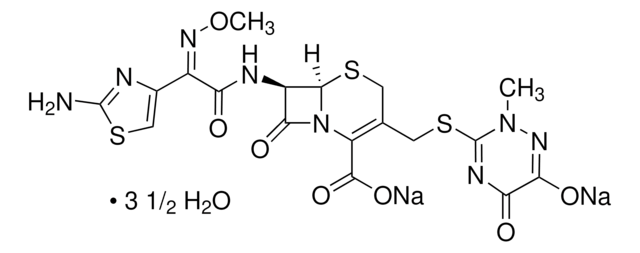C6048
Cefmetazole sodium salt
About This Item
Prodotti consigliati
Forma fisica
powder
Livello qualitativo
Durata
limited shelf life, expiry date on the label
Solubilità
H2O: 50 mg/mL
Spettro attività antibiotica
Gram-negative bacteria
Gram-positive bacteria
Modalità d’azione
cell wall synthesis | interferes
Temperatura di conservazione
2-8°C
Stringa SMILE
[Na+].[H][C@]12SCC(CSc3nnnn3C)=C(N1C(=O)[C@]2(NC(=O)CSCC#N)OC)C([O-])=O
InChI
1S/C15H17N7O5S3.Na/c1-21-14(18-19-20-21)30-6-8-5-29-13-15(27-2,17-9(23)7-28-4-3-16)12(26)22(13)10(8)11(24)25;/h13H,4-7H2,1-2H3,(H,17,23)(H,24,25);/q;+1/p-1/t13-,15+;/m1./s1
BITQGIOJQWZUPL-PBCQUBLHSA-M
Descrizione generale
Applicazioni
Azioni biochim/fisiol
Confezionamento
Altre note
Avvertenze
Danger
Indicazioni di pericolo
Consigli di prudenza
Classi di pericolo
Eye Irrit. 2 - Resp. Sens. 1 - Skin Irrit. 2 - Skin Sens. 1 - STOT SE 3
Organi bersaglio
Respiratory system
Codice della classe di stoccaggio
11 - Combustible Solids
Classe di pericolosità dell'acqua (WGK)
WGK 2
Punto d’infiammabilità (°F)
Not applicable
Punto d’infiammabilità (°C)
Not applicable
Certificati d'analisi (COA)
Cerca il Certificati d'analisi (COA) digitando il numero di lotto/batch corrispondente. I numeri di lotto o di batch sono stampati sull'etichetta dei prodotti dopo la parola ‘Lotto’ o ‘Batch’.
Possiedi già questo prodotto?
I documenti relativi ai prodotti acquistati recentemente sono disponibili nell’Archivio dei documenti.
Il team dei nostri ricercatori vanta grande esperienza in tutte le aree della ricerca quali Life Science, scienza dei materiali, sintesi chimica, cromatografia, discipline analitiche, ecc..
Contatta l'Assistenza Tecnica.

